IRMA’s Track
Irma was an interesting storm as it started as a wave of energy off the west coast of Africa that quickly became a tropical storm just a few days later. 6 days after turning into a tropical storm, it was a category 5 hurricane! It then moved through the Caribbean and eventually made landfall with southern Florida on September 10th.
Picking Up After Irma
IRMA made landfall in Florida as a strong hurricane on Sunday, which caused widespread damage across the state. Here are some images from a few Police Departments in Florida:

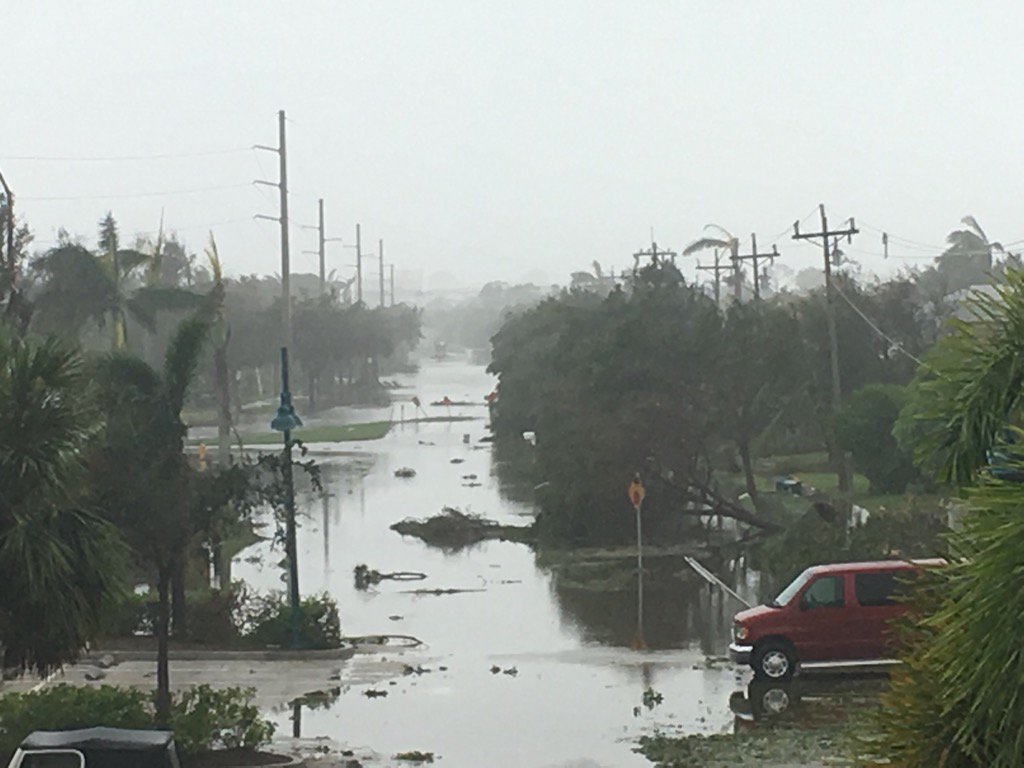
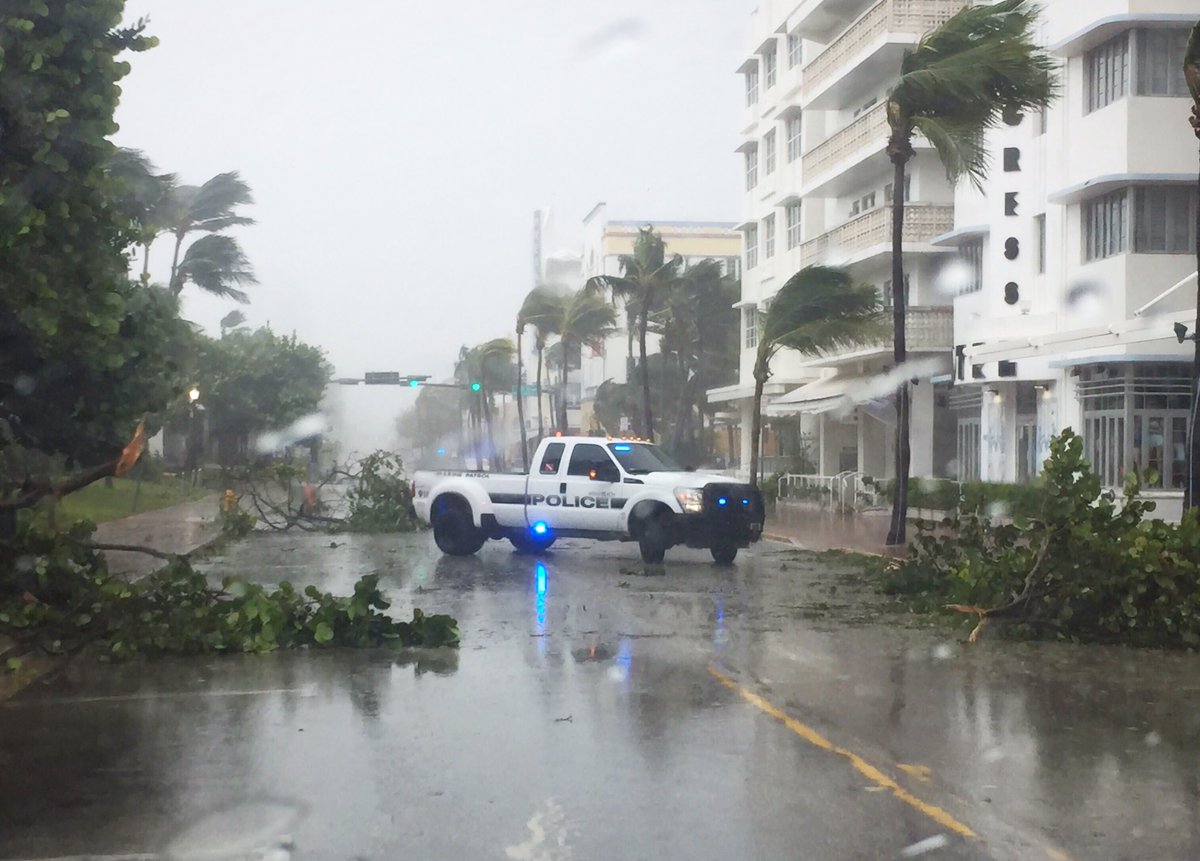
Power Outages Seen From Space
WOW! This is interesting. You can actually seen the lack of light from a satellite picture! As of Monday morning, there were more than 5.7 million people without power in Florida alone!
IRMA Disrupts Air Traffic Over Florida
Take a look at the flights across the Southeast on Sunday and note the absence of Florida! Due to the significant size of Hurricane Irma, many flights were avoiding flying over the state.
DONNA & IRMA
WOW! How about this… IRMA made landfall in the Lower Florida Keys on September 10th, which is officially the peak of Atlantic Hurricane Season. Interestingly, Hurricane Donna made landfall in the Keys on the same day back in 1960!
Record Amount of Tornado Warnings
According to the National Weather Service out of Melbourne, FL, there were 48 tornado warnings issued for their DMA on Sunday, September 10th, which is the greatest amount of tornado warnings issued by their office for any single day. The next greatest was 15 back on August 19th, 2008. Also, the state of Florida had a record number of tornado warnings at 69 on Sunday, September 10th beating the previous of 47, which was set on June 24, 2012
IRMA Makes Landfall As A Major Category 4 Storm
This was the radar loop from early Sunday morning as Hurricane Irma officially made landfall along the Florida Keys. After briefly dropping down to category 3 strength during the day Saturday, IRMA intensified to a category 4 storm with sustained winds of 130mph (pressure at 929mb) just before making landfall in Cudjoe Key in the Lower Florida Keys at 9:10am Sunday morning. Interestingly, NEVER on record has there been (2) Category 4 hurricanes to make U.S. landfall in one Atlantic hurricane season until now! Hurricane Irma in the Florida Keys on Sunday, September 10th and Hurricane Harvey on Friday, August 25th. At 3:35pm, there was a second landfall near Marco Island, FL as a category 3 storm with winds of 115mph (pressure at 940mb).

Satellite Loops of IRMA
.gif)
.gif)
.gif)
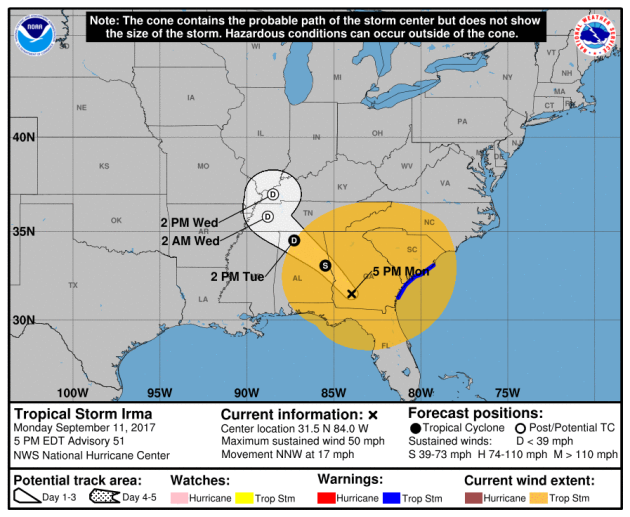
Tracking IRMA

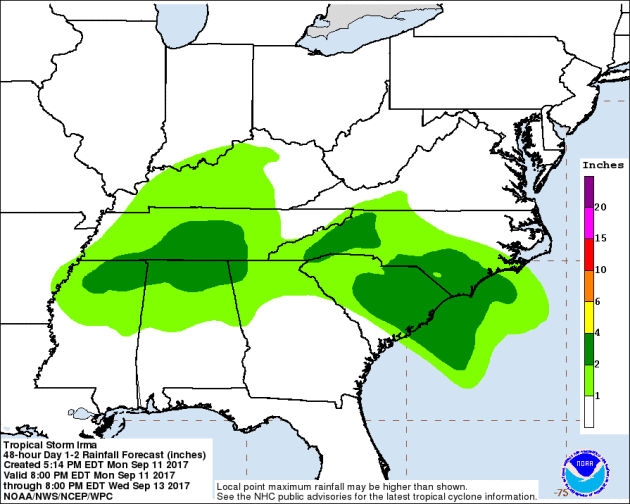
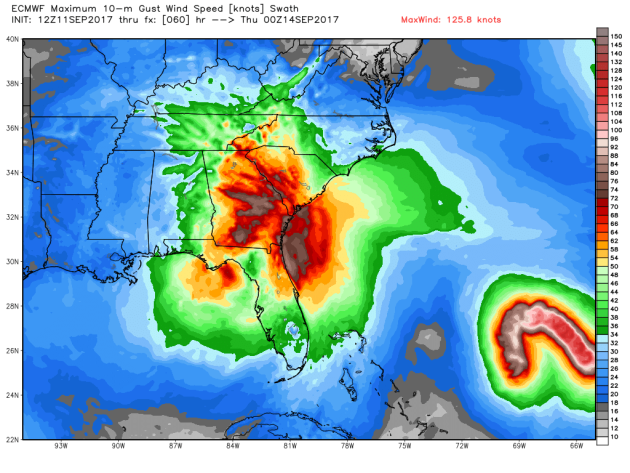
________________________________________________________
Still Tracking JOSE in the Atlantic



____________________________________________________________
.png)
__________________________________________________________
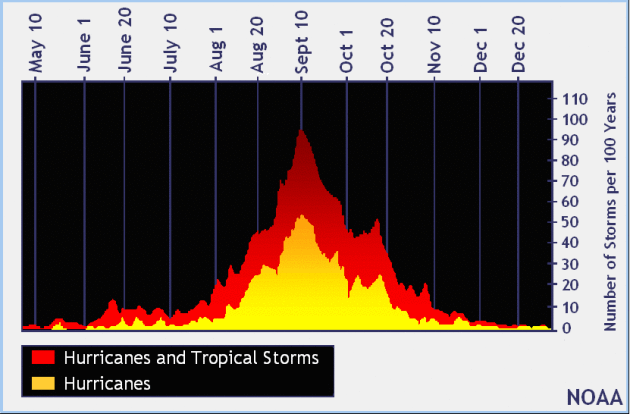
___________________________________________________________
It certainly has been a fairly active first half of 2017 with 1344 preliminary tornado reports through September 9th. Note that this is the most tornadoes through September 9th since 2011, when there were 1,782 reports. The map below shows the distribution of the tornadoes so far this year.
PRELIMINARY 2017 Tornado Count
According to NOAA’s SPC, the PRELIMINARY 2017 tornado count is 1344 (through September 10th). Note that is the most active year for tornadoes since 2011, when there were 1,782 tornadoes. Keep in mind there was a major tornado outbreak in the Gulf Coast region from April 25-28, 2011 that spawned nearly 500 tornadoes, some of which were deadly. That outbreak is known as the Super Outbreak of 2011 and has gone down in history as one of the biggest, costliest and one of the deadliest tornado outbreaks in history.
.png)
_____________________________________________________________________
National Weather Hazards Ahead…
1.) Heavy rain for the northern Rockies and northern high Plains, Thu-Fri, Sep 14-15.
2.) Much below-normal temperatures for the northern Rockies and northern high Plains, Thu-Sun, Sep 14-17.
3.) High winds for parts of the Aleutians and the Alaska Peninsula, Fri-Sun, Sep 15-17.
4.) Significant waves shifting north from the Carolinas to the mid-Atlantic, Sat-Mon, Sep 16-18.
5.) Significant waves from the mid-Atlantic north to New England, Tue-Wed, Sep 19-20.
6.) Flooding occurring across parts of southeast Texas.
7.) Flooding likely across the Florida Peninsula.
8.) Flooding possible across parts of Florida, Georgia, and the southern Appalachians.
9.) A slight risk of much below-normal temperatures for parts of the western U.S., Tue-Thu, Sep 19-21.
10.) Severe drought across the Middle Mississippi Valley, the Northern Plains, the Northern Rockies, and Hawaii.
.png)
_________________________________________________________
“The unprecedented drought that’s crippling Montana and North Dakota”
It came without warning, and without equivalent. Now a flash drought is fueling fires and hurting the lives of those who work the land. When Rick Kirn planted his 1,000 acres of spring wheat in May, there were no signs of a weather calamity on the horizon. Three months later, when he should have been harvesting and getting ready to sell his wheat, Kirn was staring out across vast cracked, gray, empty fields dotted with weeds and little patches of stunted wheat. “It’s a total loss for me,” said Kirn, who operates a small family wheat farm on the Fort Peck Reservation, an area of north-eastern Montana that lies right in the heart of the extreme climatic episode. “There’s nothing to harvest.”Kirn’s story is typical across the high plains in Montana and the Dakotas this summer, where one of the country’s most important wheat growing regions is in the grips of a crippling drought that came on with hardly any warning and, experts say, is without precedent.”
See more from the Guardian HERE:
(A wildfire burns in the Lolo national forest in Montana in August. The severe drought has served as ideal conditions for continued fires. Photograph: Rion Sanders/AP via The Guardian)
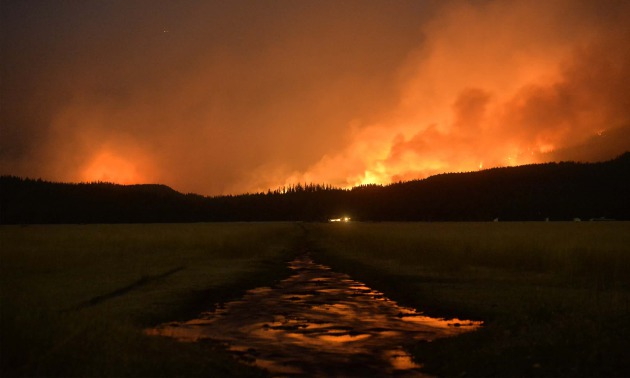
Latest Drought Monitor
Here’s the latest drought update from the US Drought Monitor, which shows EXCEPTIONAL drought conditions, which now covers nearly 26% of Montana. Note that 91% of the state is in a MODERATE drought. In North Dakota, more than 25% of the state is considered to be in an EXTREME drought.
Rain Needed to End Drought
Chetco Bar Fire – 5 Miles Northeast of Brookings, OR
The Chetco Bar Fire in near Brookings, Oregon is a very large wildfire in the Western US that started on Wednesday, July 12th by lightning and has grown to more than 182,000 acres! There are more than 1,400 people working on this fire, which is only 5% contained. The estimated containment date is set for Sunday, October 15th.
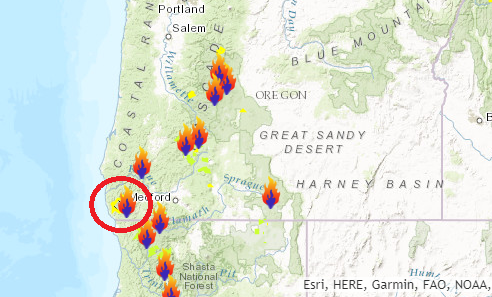
Here’s a look at the current wildfire map across the country. Continued hot and dry weather has helped to spark several wildfires across the Western US. There have even been fires popping up in the Eastern U.S., two of the larger fires are burning in Florida.
Here’s a list of all the current large wildfires from Inciweb:
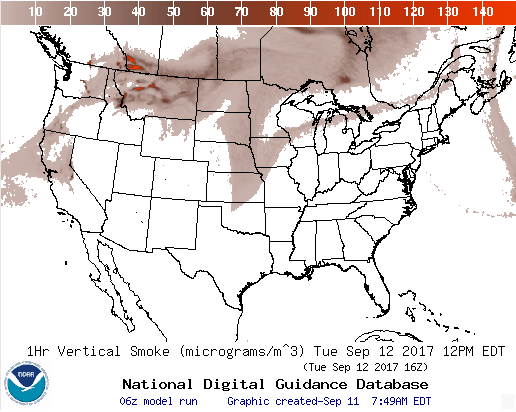
National Weather Outlook
Here’s the weather outlook through midweek, which shows the remnants of IRMA moving through the Southeast with more heavy rain and gusty winds. The good news is that it will continue to weaken with as areas of heavy rain begin through the 2nd half of the week. Also note the next wave of energy moving into the Western US areas of heavy rain. There also appears to be enough cold air for some of the first snow of the season across the high elevations in the Northern Rockies.
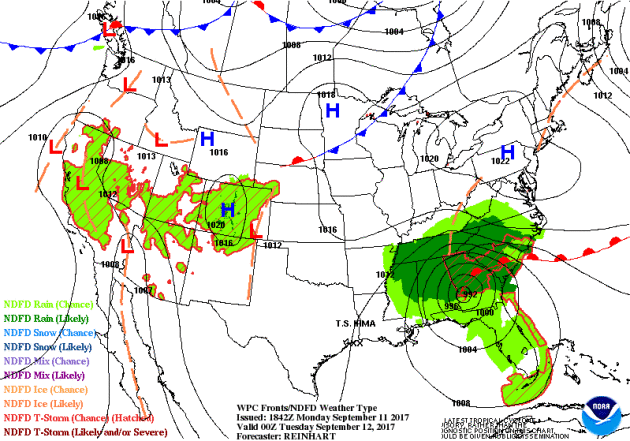
5 Day Precipitation Outlook
According to NOAA’s WPC, the next several days could produce areas of locally heavy rainfall across parts of the Southeastern and Northwestern US. The remnants of IRMA will continue to push through the Southeast through the first part of the week. The next system moving into the Western US will produce areas of 2″ to 4″ rainfall tallies. Note that some of the heaviest will be found in Montana, where they really need it! There may also be some SNOW in the higher elevations!
.gif)
According to NOAA’s WPC, there is a MODERATE risk of excessive rain on Monday across parts of the as heavy rain from Hurricane IRMA lifts north. By Tuesday, the heaviest rainfall will likely start fading, but there is still a MARGINAL risk of heavy rainfall
.gif)
.gif)
________________________________________________________________________
By Paul Douglas
_______________________________________________________
This Day in Weather History
September 12th
1982: Two tornadoes touch down in Benton County. The F2 tornado causes $250,000 worth of damage, and an F0 tornado causes $25,000.
1931: The fifth consecutive day of 90 degrees or above occurs in the Minneapolis area.
1923: Winter weather pays an early visit to northern Minnesota. The cities of Roseau and Virginia receive flurries and sleet.
1903: 4.96 inches of rain fall in the Minneapolis area.
1869: A hail storm between 1 and 3 am breaks windows and causes considerable damage to late vegetables at Madilia in Watonwan County.
________________________________________________________
Average High/Low for Minneapolis
September 12th
Average High: 73F (Record: 94F set in 1948)
Average Low: 54F (Record: 36F set in 1940)
Record Rainfall: 4.96″ set in 1903
_________________________________________________________
Sunrise/Sunset Times for Minneapolis
September 12th
Sunrise: 6:48am
Sunset: 7:29pm
Hours of Daylight: 12hours & 40mins
Daylight LOST since yesterday: ~3 minutes and 4 seconds
Daylight LOST since summer solstice (June 20th): ~2 hours & 57 minutes
__________________________________________________________
Moon Phase for September 12th at Midnight
0.0 Days Before Last Quarter
.gif)
Tuesday will be another summerlike day with highs in the 70s and 80s across the state. The good news is that it won’t be quite as humid as it was on Monday as dewpoints will likely slip into the 50s across much of the state.

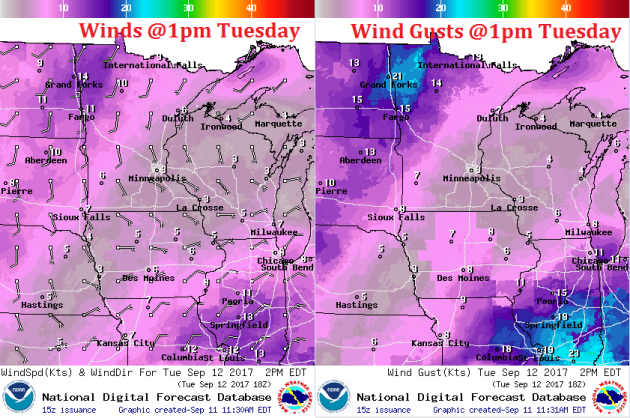
Weather Outlook For Tuesday
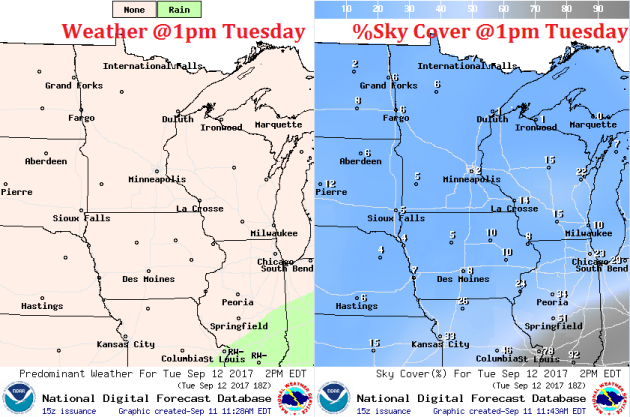
UV Index for Tuesday – HIGH
The UV Index for Tuesday will be HIGH, which means that it will only 20 to 30 minutes or less to burn unprotected skin. With that said, if you are planning on spending any extended length of time outside, make sure you wear appropriate attire and lather on the sun block!
__________________________________________________________________________
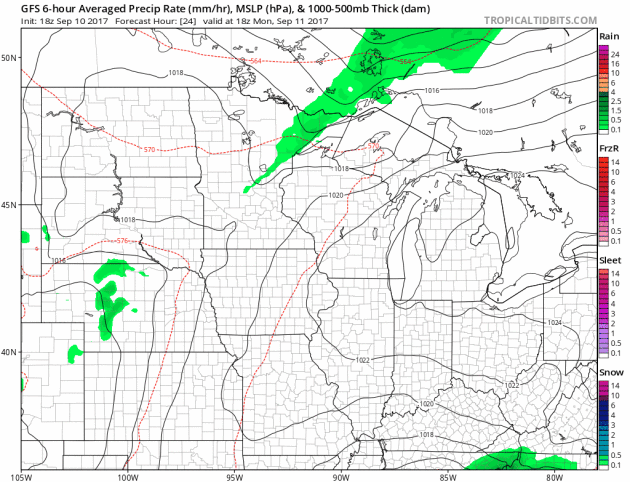
Rainfall Potential Ahead
.png)
______________________________________________________
Pollen Forecast
____________________________________________________________________________
Minneapolis Temperature Outlook
Here’s the temperature outlook through September 25th, which shows temps warming into the 80s this week, but will fall into the 60s and 70s as we head into the 2nd half of the month.

According to NOAA’s CPC, the extended temperature outlook from September 16th through the 20th suggests warmer than average temperatures settling back in across much of the Midwest, Great Lakes and Central part of the country.
___________________________________________________________
Extended Temperature Outlook
According to NOAA’s CPC, the extended temperature outlook through September 20th shows that a good chunk of the Eastern and Southern U.S. will be warmer than average, but the Northwestern US will remain cooler than average.
__________________________________________________________
___________________________________________________________________
_________________________________________________________________
___________________________________________________________
“Fires, droughts and hurricanes: What’s the link between climate change and natural disasters?”
“With Hurricane Irma smashing into Florida so soon after Hurricane Harvey flooded southeastern Texas — and as wildfires burn through the western United States — extreme events have been hitting the U.S. from all sides. To what extent does climate change influence them? Here are a few ways researchers think that climate change’s effects could play out. SEA LEVEL RISE AND STORM SURGE: As sea levels continue to rise due to global warming, they’re increasing the risk of storm surge — the dangerously high floods caused by a storm pushing water onshore. Those floodwaters are responsible for much of the damage left by hurricanes — particularly in highly populated coastal cities.
A 2013 study in PNAS found that the risk of a Hurricane Katrina-level storm surge rose two to seven times for every 1.8-degree Fahrenheit increase in temperature.”
_____________________________________________________________“Beached Manatees Rescued From Low Tide In Wake of Hurricane Irma”
“A group of Florida residents came across two beached manatees Sunday afternoon in a bay that had dried up as a result of Hurricane Irma. The manatees were stuck in the mud about 100 yards from deeper water, near Whitfield Avenue and U.S. Route 41 in Manatee County, Florida, the Bradenton Herald reported. “We had to do something about it,” local resident Tony Faradini-Campos told the Sarasota Herald-Tribune. “We couldn’t just let those manatees die out there. We shared the pictures on social media and it just blew up.” The individuals who found the manatees originally tried to move them themselves, but were not successful and had to bring in further assistance. “We actually reached out to some friends who work for the county that ended up going out there and rescuing them,” Michael Sechler, one of the passersby who discovered the manatees, told HuffPost. Two Manatee County deputies and officials from the Florida Fish and Wildlife Conservation Commission came to the bay to help the rescue effort, the Herald-Tribune reported.”
See more from HuffingtonPost HERE:
__________________________________________________________________“Dissecting the parts of a hurricane”
Irma is a big one. Its circulation spans hundreds of miles in all directions, large enough to fully engulf the entire peninsula of Florida at once. Hurricane-force winds extend outward up to 80 miles from the center, with blustery conditions felt from the Caribbean to the Carolinas. With impacts felt across such a wide area, it’s important to understand the threats of each part of Irma; whether it’s the spiral rainbands or the infamous eyewall, danger extends well beyond Irma’s center. The most dangerous ‘right-front quadrant’ Irma is like a giant atmospheric buzz saw, scouring the ground wherever she strikes. But if you picture this counterclockwise spinning saw blade moving along the ground at a forward speed of 15 mph, it stands to reason that winds on the right-hand side would be amplified by this motion. If the storm is spinning at 120 mph and trekking along at 15, then gusts to 135 would buffet areas beneath the right-side eyewall. Likewise, this effect actually makes life a bit easier on the left side; there, surface winds are reduced to “only” 105 mph, lessening the ferocity of the storm. For that reason, you may have heard meteorologists refer to the “right front quadrant” of Irma as the most dangerous sector of the storm.
See more from WashingtonPost HERE:
.jpg)
________________________________________________________________
“Why Hurricane Harvey and Hurricane Irma Are Terrific News For This One Company”
“As Houston tallies up the damage from Hurricane Harvey and Florida prepares for Irma’s potential landfall, Wall Street investors are searching for potential winners amid what are shaping up to be two of the costliest storms in U.S. history. One such high-climber? Lumber Liquidators, a hardwood flooring firm that could benefit as homeowners seek material to rebuild. Lumber Liquidators has been in a slump since 2015, when 60 Minutes reported, and the CDC later confirmed, that some of its products could increase users’ risk of cancer. The company’s stock rallied slightly after the U.S. Consumer Product Safety Commission completed a probe without issuing recalls. But the Commission also failed to reassure consumers with health concerns, causing lasting damage to the brand’s appeal. But Lumber Liquidators’ stock is now hitting levels not seen since just after the 60 Minutes segment — in part thanks to Hurricane Harvey and Hurricane Irma.”
See more from Fortune.com HERE:
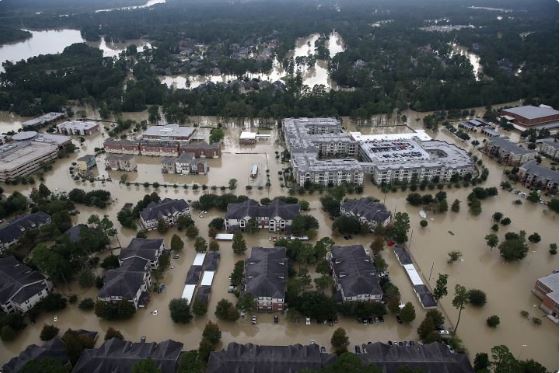
___________________________________________________________________________“The Role Of Climate Change In Extreme Weather Events”
“As Houston struggled in the aftermath of the record-breaking rainfall from Hurricane Harvey, and no fewer than three hurricanes simultaneously moved across the Atlantic basin, a reader asked if I could explain the role of climate change in the recent extreme weather events. I want to connect the dots with arguments that aren’t really controversial. First, is the climate changing? Almost everyone would agree that this is the case. What some would dispute is whether human activity is a significant contributor. I accept that it is, but I won’t attempt to make that case here. If you don’t accept that human activity is impacting the climate, I won’t be able to convince you in a short article here. But let’s agree that the climate is changing. There are multiple lines of evidence that indicate that the earth is warming. One piece of evidence is that the surface temperature of the oceans is climbing. NOAA (National Oceanic and Atmospheric Administration) has determined that since 1880, the average global surface temperature of the ocean has increased by about 1 degree Fahrenheit (°F). (See their methodology here). Relative to the average temperature from 1971 to 2000, the surface temperature over the past five years has risen about 0.5°F.”
See more from Forbes.com HERE:
(A convenience store owner walks through floodwaters from Hurricane Harvey outside an Exxon Mobil Corp. gas station in Houston, Texas, U.S., on Wednesday, Aug. 30, 2017. Unprecedented flooding from the Category 4 storm that slammed into the state’s coast last week, sending gasoline prices surging as oil refineries shut, may also set a record for rainfall in the contiguous U.S., the weather service said Tuesday. Photographer: Luke Sharrett/Bloomberg)
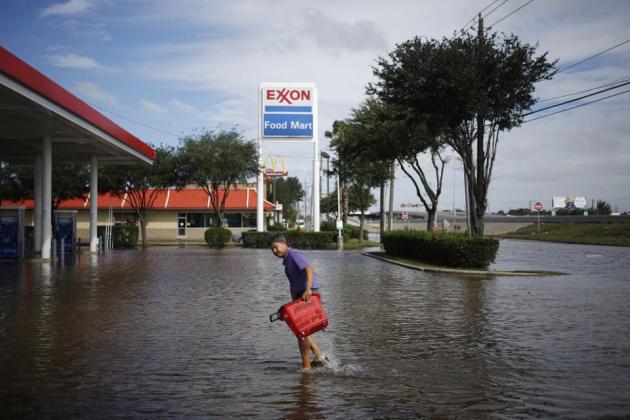
_________________________________________________________________________


